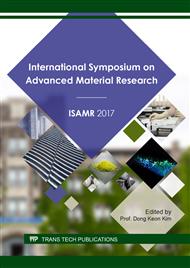p.123
p.129
p.134
p.143
p.148
p.156
p.163
p.168
p.173
A Process Study of Organic/Inorganic Film Materials Deposited by ICP-PECVD at Low Temperature
Abstract:
The film package of organic device plays an important part in organic electronics manufacturing. In order to get high efficiency encapsulation film material, we developed a set of inductively coupled plasma chemical vapor deposition system (ICP-PECVD). A process study on Organic/inorganic hybrid material deposition was carried out for permeation barrier application. In the study, the effects of plasma power, bias power and deposition temperature on film properties were investigated. Fourier transform infrared spectrometry (FTIR), ellipsometer and transmission electron microscopy (TEM) were used to characterize the film properties. The increase of ICP power is favor to SiOx growth with limits. Bias power increases deposition rate. Film density will increase with the rise of deposition temperature. It was found that the ratio of O2/HMDSO flow rate was the key factor to obtain organic layer or inorganic layer. Since the ratio of O2/HMDSO flow rate increase to 10:1, HMDSO will be completely oxidized and Si-O-Si bonds are formed. As the result, the organic film can be obtained with the no oxygen deposition process. Hybrid film between organic film and inorganic film can be deposited under the condition of O2/HMDSO gas flow ratio less than 10:1. Water vapor transmission rates (WVRT) of organic film, inorganic film and organic/inorganic stacks are also tested. The experimental results show that the inorganic thin film has good performance in water or oxygen permeation; organic thin film is mainly for flexibility and inorganic film growth stress release. And interfacial characteristics between inorganic film and organic film have influence on water and oxygen barrier. As result, we obtained the single inorganic film with WVRT of 4.3×10-2g/m2 day and the four cycles organic / inorganic alternating structure film with WVRT of 3.66×10-4g/m2 day.
Info:
Periodical:
Pages:
148-155
Citation:
Online since:
August 2017
Authors:
Keywords:
Price:
Сopyright:
© 2017 Trans Tech Publications Ltd. All Rights Reserved
Share:
Citation:


